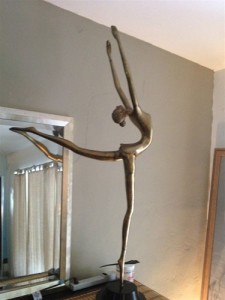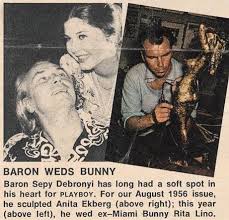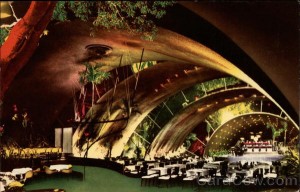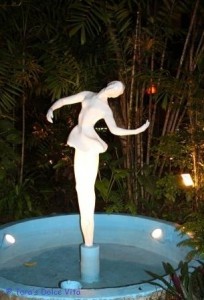 Baron Joseph “Sepy” De Bicske Dobronyi (April 20, 1922 – May 29, 2010) Hungarian-born sculptor and royal crown jeweler,aristocrat, art collector, world traveler, movie maker, pilot, wine collector, sportsman, playboy, and bon vivant who live many years in Cuba. Sepy, as he became known, was the artist and jeweler whose name had been familiar in international society and movie circles as well as the art crowd. Baron Sepy was world renowned for his bronze and gold sculptures of famous celebrities such as the controversial 42″inch tall Golden Statue, of movie star Anita Ekberg who posed for him and gained recognition worldwide. “The Ekberg Bronze”, was featured in the August 1956 issue of Playboy magazine by Hugh Hefner, a friend of Sepy.
Baron Joseph “Sepy” De Bicske Dobronyi (April 20, 1922 – May 29, 2010) Hungarian-born sculptor and royal crown jeweler,aristocrat, art collector, world traveler, movie maker, pilot, wine collector, sportsman, playboy, and bon vivant who live many years in Cuba. Sepy, as he became known, was the artist and jeweler whose name had been familiar in international society and movie circles as well as the art crowd. Baron Sepy was world renowned for his bronze and gold sculptures of famous celebrities such as the controversial 42″inch tall Golden Statue, of movie star Anita Ekberg who posed for him and gained recognition worldwide. “The Ekberg Bronze”, was featured in the August 1956 issue of Playboy magazine by Hugh Hefner, a friend of Sepy.
Joseph De Bicske Dobronyi was born to József Dobronyi and Szidónia Petric, in the town of Bicske, Hungary, on April 20, 1922. His parents were selected to be the crown jewelers to the Royal House of Hungary dating back as far as the 15th Century. The Dobronyi family ancestors trace back to 1414, when they constructed their castle.
In 1585, the family was bestowed with the title, “Baron”. The Hungarian-born Dobronyi’s title is a hereditary one bestowed by the King in 1540, when one of Dobronyi’s ancestors, who had a private army, routed the Turks from Hungary after 150 years of occupation.
In 1940, Dobronyi was drafted into World War II, had served as a pilot in the Hungarian Air Force.[16] He specialized in transporting the wounded to hospitals from the front lines for the Red Cross. Joseph was one of six pilots chosen to try out the world’s first Rocket-powered aircraft. In 1945, he was captured by the Russians, after his airplane was shot down in flames over Hungary and escaped by parachute.
Europe to Cuba.
Hiding out for a few months, he managed to earn a living by working odd jobs. He obtained a job as an interpreter for the American Military Mission, also known as Diplomatic mission, where his talent of speaking six languages were useful. He spoke Hungarian, French, English, German, Swedish and Spanish.
Six months later, he wandered into Stockholm and started an apprenticeship at the House of Thomason, crown jewelers for the Swedish Royal Family. There Dobronyi studied wood and metal working, ceramics, and sketching. By 1947, he was selected to execute the design of the brooch that Folke Bernadotte gave to Princess Elizabeth on the occasion of her engagement to Prince Phillip.
At this time, an offer was presented by the King Gustaf V of Sweden to Dobronyi to travel to Caracas, Venezuela, which he accepted, in order to leave Europe and venture out on his own. He boarded a plane, on New Year’s Eve 1947, where his final destination was not reached due to a layover in Havana, Cuba. Dobronyi with only $150.00, his suitcase and the suit on his back had the urge to have an epic New Year’s Eve decided to stay in Cuba. Since the Caracas contract was never signed, Dobronyi searched for a job and was able to find work in a jeweler’s shop. This job enabled him not only to survive to start saving in order to purchase his own tools. Gradually he began designing his own ideas, and working on them in his apartment after hours. His dedication and love for the arts proved fruitful as he started to build up a clientele and within a year he was able to fund his own studio. He incorporated his European style, and with his elegant and original approach to his designs, and the attraction from the Cuban society proved successful. Each work was signed with his trademark signature, “Sepy”. His clientele included American tourists and people in the entertainment industry as well as the local Cuban society. In few years, his studio became the mecca for celebrities such as Ernest Hemingway, Errol Flynn, and Nat King Cole to name a few. A necklace of shells in a net design was made for Mary Welsh Hemingway, who personally requested it. This brought more American customers to Dobronyi as well, as publicity for his studio with the magazines and newspapers in the U.S..
During this time, Dobronyi’s studio in Havana was doing very well, and the reputation he had with society was positive, he was able to take some time to dedicate to his first childhood fascination, African sculpture. He had always found time for his carvings throughout the years, and in the 1970s he made five expeditions to New Guinea in search of Asmat art.
While in Cuba, he came across old African Native Art with this his art became known as Afro-Cuban Sculpture. Dobronyi was welcomed into the secret ritual dances and festivals of the Namigos, who were the Afro-Cuban group of natives. This was an honor to be welcomed into these ceremonies as they were more secret than any of the other South American Tribes.
Cuba to America.
Dobronyi came to the United States in 1959 when Castro took power in Cuba. On December 20, 1963, 40-year-old Dobronyi, who had citizenship in Hungary, Sweden and Cuba, was sworn in a federal courtroom, as a United States citizen by Judge Emett C. Choate. The Federal Building held a pre-holiday session and this was a very special day for the Baron as it had been a goal of his ever since the days of World War II.
Romantic Relationships.
Dobronyi claimed romantic involvements with celebrities and personalities, including Anita Ekberg, whom Sepy met at a Los Angeles art gallery exhibit of primitives, when she was herself unknown; Ava Gardner; Brigitte Bardot; and Linda Christian. His marriages were with Alicia Hartman y Portela (5 June 1953 – 17 May 1960) (divorced). Alicia was the daughter of Walter Hartman, owner of the first Chrysler car dealership in La Havana, Cuba.
Amy Green Brown (11 August 1922 – 19 November 1989) (divorced). New York heiress, daughter of Norvin Hewitt Green and Irene Pierce of New York.
In 1969, Dobronyi married third wife Annette Nordquist (1969-1972), a statuesque Swedish blonde. Two years later, the Herald reported that at 8:12 a.m. on July 1, 1971, Dobronyi became the first person in Miami to file for a no-fault dissolution under a revised state divorce law effective at midnight.
Playboy Bunny Rita Lino (9 May 1977 – 1983) (divorced).
From those marriages were sons Joseph (26 April 1961 ) (born Joseph Bicskei Dobronyi Jr.) — with Amy Green Brown Dobronyi and Ferenc (22 September 1962) (born Ferenc Norvin Dobronyi) — with Amy Green Brown Dobronyi.
Works of Arts and achievements.
As Jeweler.
“Emerald and Diamond Peacock Brooch for Princess Elizabeth, (Sepy)” (1947), Sweden
Among Dobronyi’s accomplishments is a $15,000 emerald and diamond peacock brooch, which Prince Carl Bernadotte of Sweden presented to Princess Elizabeth upon her engagement to Prince Phillip.
“Ring Miniature of St Edward’s Crown for Princess Elizabeth, (Sepy)” (1947), Sweden
In 1947, Dobronyi was commissioned by Count Folke Bernadotte, to make a wedding present for Princess Elizabeth, as she was then. He worked for six months making a ring in the form of a miniature St Edward’s Crown. Each ruby, diamond and pearl was an exact miniature of the original.
“Platinum and Gold Diamond-Crusted Pendant, (Sepy)”, Havana, Cuba
Sold for $1,100 and now is displayed in Havana at the Cuban Art Center. A woman had seen the pendant and had liked it but did not have the money to purchase it, so Dobronyi told her to take it. He lost track of her for about six months, and then a check arrived.
“Diamond Earrings, (Sepy)”
Featured on model in the issue of Harper’s Bazaar, January 1954 in the article, ‘Flying Down to Cuba’.
“Sun Goddess Bracelet, (Sepy)”
Featured on Royal Blend by Coppertone, a suntan lotion ad in the June 1963 issue of Vogue.
“Ring for Lena Horne, (Sepy)” (1953), Havana, Cuba
World-famous singer, Lena Horne, requested an exotic ring to be designed that was especially designed for spot-lights. Horne and Dobronyi arranged a meeting at La Bodeguita del medio were the ring was unveiled, as he described all the advantages the ring was designed to have.
Sculptor.
The Ekberg Bronze.
“The Ekberg Bronze, (Sepy)” (1956), Havana, Cuba
Dobronyi’s nude of the statuesque Anita Ekberg which was featured in Playboy magazine, August 1956 issue. Dobronyi thought up an experiment in melting gold on bronze and three months later he completed his 35″ inch high, 40-pound Ekberg statue. It is a very realistic statue that spread his fame throughout Cuba. The controversial gold and bronze statuette was sold to a “private museum in Norway” for an undisclosed price on November 28, 1958. It is later told that Dobronyi earned $12,000 for the golden nude. Some of this money came from the sale of reproduction rights to a magazine; part from subsequent exhibition fee: part, finally, from the sale of the statuette to the National Museum in Oslo, through a well-known collector.
La Bardot.
“La Bardot, (Sepy)” Statuette of Bridgette Bardot.
The Golden Virgin.
“The Golden Virgin, (Sepy)” (1962), Havana, Cuba
The Golden Virgin, was the latest nude creation, a statue which will join the ranks of such stellar sculptings as Jayne Mansfield, Ava Gardner, Bridgette Bardot and Anita Ekberg Sepy’s candidates for his “Hall of Beauty” were based on personality rather than measurements. His subjects from a wide personal knowledge of famous stars and models. Didi Roberts was the model for the Golden Virgin at the age of 25. She had appeared on television and in motion pictures such as The Eddy Duchin Story and Solid Gold Cadillac.
Lithe Nymphet Beverly.
“Lithe Nymphet Beverly, (Sepy)” (1958), Havana, Cuba
Commissioned by Errol Flynn assisted in the talent scout of this gold-plated nude, Beverly Aadland when she was 17. This was an 18″ reclining figure which Flynn displayed in his home in Jamaica. It sold for $5000.00.
The Birds.
“The Birds (Sepy)” (1963), Coconut Grove, Florida
In 1963, Dobronyi was working on assignment for Alfred Hitchcock fashioning a three-foot high piece of art, done entirely in sterling silver with the design of 200 tiny birds in a spiral.
The Cosmopolitan Primitive.
“The Cosmopolitan Primitive (Sepy)” (1956), New York, New York
Sepy at the time was a resident of Havana, Cuba, had been his own gold supplier for his famous Gallery of Beauties. He had discovered sunken Spanish ships with buried treasure while diving in the sea around Cuba. The treasure hunt was very successful. Dobronyi located thirty-five sunken galleons and managed to salvage £50,000-worth of gold doubloons.
In Cuba, Sepy combined his early African passion with the equally exciting Cuban rhythm of life. With the innate taste and his own talent he has used the primitive African approach to art and has brought his own feelings and sensitivity to the carving of figures in the true tribal approval. His collection, The Cosmopolitan Primitive, was displayed by Gene Moore, the talented display director of Bonwit Teller.
Tropicana Club.
“Miniature of the outdoor stage of the Tropicana Club (Sepy)”, Havana, Cuba
Dobronyi designed a small sculpture for the world famous casino, The Tropicana Club in Havana, Cuba.
Gold Umbrella.
“Gold Umbrella (Sepy)” (1962), Coconut Grove, Florida
Gold Umbrella, given to Debbie Reynolds, after her success in Singing in the Rain.
The Vigia.
“The Vigia, (Sepy),” (1956), Havana, Cuba
The sculpture (34.5 by 8 by 16.5 cm, or almost 14 by 3 by 6 in.) shows a crouching or squatting African figure, with wavy hair, its elbows on its knees and its hands on the ears. The sculpture has two functions: to protect the house when its owner is absent, and to protect the owner from illness and danger when he is hunting. “Vigia” is now part of Mary Hemingway’s library, Finca Vigía, which has items of artistic and historic significance.
Diana the Huntress.
“Diana the Huntress (Sepy)”
A wrought-iron, ‘Diana the Huntress’, was purchased by Jack Linkletter after Dobronyi had appeared on his television show.
Dobronyi’s trademark while living in Cuba, was a pocket full of shark’s teeth which he passed out to the girls of his choice. Over 600 females are a member of the Shark tooth club.
Organizations.
Cuban Art Center.
Dobronyi was one of the best known men in Havana. Old tourist literature credits Dobronyi as the founder of The Cuban Art Center in 1951. It was a cooperative attempt to provide a broader audience for the artists of Havana and the island and to stimulate the sale of their works. He had always been interested in Cuban culture and specialized in primitive, semi-abstract sculpture. A modern “Native Bazaar”, which centralized the display of the art and sculpture of 187 Cuban artists, put shirts on artists’ backs and bankbooks in their pocket for the first time in the island’s history.
Bodeguita del Medio, La Havana, Cuba.
Dobronyi was also the co-owner of ‘the Bodeguita del medio’ which was the hangout for the jet-setters of that era. In 1951, Dobronyi convince owner Angel Martinez to convert his store into a tavern. There he became the hub of not only the art community but also of the social circles. Close friends were Ernest and Mary Hemingway, Hugh Hefner, Nat King Cole John Wayne and Errol Flynn to name a few.
Discography There is an LP: Sepy Presents: La Bodeguita del Medio, The Music of Havana’s Most Fabulous Cafe. Recorder by Riverside Records and Produced by Bill Grauer Productions, Inc, New York, 1957. Ye Little Wood House.
Socialites.
Dobronyi knew heads of states, socialites, jet setters, authors, artists, just plain folks and more than a few headhunters.
Errol Flynn, arranged the model for Beverly Aadland Statuette. Flynn commissioned Sepy to decorate his house, in Jamaica. Antiques, pieces of native art by the dozen and a golden statue of Beverly “Woodsy”, who had been Errol’s protégée, then appearing in Cuban Rebel Girls which Sepy was the production manager for, were the items that filled Flynn’s home.
Ernest Hemingway and Mary Hemingway.
Gleb Derujinsky, photographed Sepy, as a model, in the article featured in Harper’s Magazine, January 1954, Flying down to Cuba.
Robin Hanbury-Tenison, one of the greatest explorers and authors, united with Sepy upon arriving in Cuba. They spent time exploring the island and socializing with Flynn and many other celebrities on the island. Hanbury-Tension finalized his book, ‘Worlds Within’ and included the Baron as one of the most exotic characters he had ever met.
Death.
Dobronyi died of liver cancer on May 29, 2010, at Mount Sinai Medical Center in Miami Beach at age 88. The estate has been auctioned on Ebay and other auction houses which included exotic pieces of history. Items in the estate included a sea serpent Viking ship by shipbuilder Bill Sjogren from Norway, artifacts from Bali, a dragon-headed gong stand from Tibet. Sculptures and jewelry Sepy crafted, as well as antique Chinese drum, a diminutive Balinese door made into a distinctive table, Cuban furniture, and his Asmat art from expeditions to New Guinea, once considered the largest private collection.
Agencies/Various/InternetPhotos/YouTube/TheCubanHistory.com
The Cuban History, Hollywood.
Arnoldo Varona, Editor.












